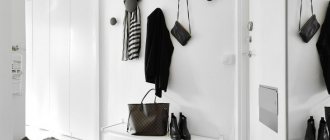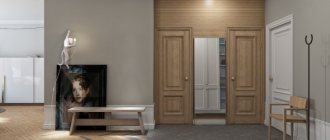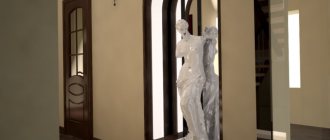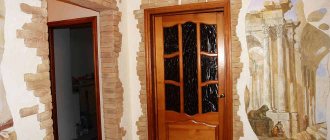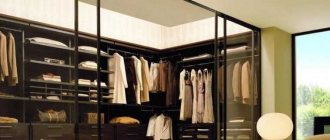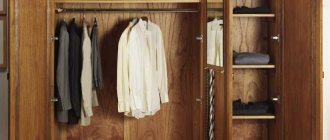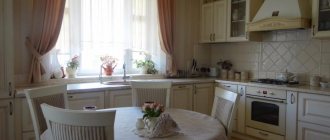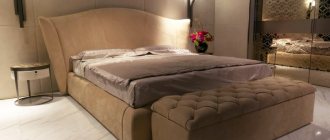30063
Decorating narrow spaces is not as easy as it might seem. Not every person without design skills will be able to rationally plan the space of a narrow corridor. We invite you to find out how useful, functional and convenient a shoe cabinet with a seat in the hallway can be, what are the features of its selection and placement.
What types of shoe cabinets are there?
A shoe rack is usually understood as a cabinet or cabinet designed for storing boots, shoes, and sneakers. Another widespread name for the item is galoshnitsa.
The simplest models that can be found on the market are low cabinets with open or closed shelves.
Modern manufacturers are increasingly offering customers products with advanced functionality.
They are additionally equipped with seats, mirrors, key holders, drawers for small items, clothes hangers, and shelves for hats. However, when choosing such items, you should remember the area of the room.
In small hallways, narrow, tall shoe racks with hinged doors are usually installed.
They have a number of advantages over their counterparts:
- Capacity. These cabinets are equipped with several rows of shelves. Usually these are two, three or four rows. They can easily fit the shoes of all family members.
- Small sizes. The narrowest models that can be found in furniture stores are about twenty centimeters wide. Shoes in them are placed vertically. The height depends on the number of shelves. The tallest models can reach one and a half meters, the lowest - fifty centimeters.
- Aesthetic appearance. Folding doors hide shoes from prying eyes and protect them from dust, small children and pets.
A closed shoe storage system can be made in different ways. All models can be divided into several groups:
With folding shelves.
A shoe rack in a hallway with folding shelves usually has a shallow depth; they vary in height and width - low and wide, narrow and high. Their distinctive feature is a shelf attached to the door, and this structure is fixed on rotary hinges.
When you pull the handle on the door, it rotates on its hinges, allowing access to the contents of the drawer.
With hinged doors.
This is an ordinary shoe cabinet, of a wide variety of sizes, for different numbers of shoes.
With sliding doors.
These models are good if the hallway is very narrow and open doors will get in the way. Such furniture for storing shoes is called a chest of drawers or (cabinet) for shoes. There is no clear division. Everyone uses the name they like best.
Closed models
Closed models of shoe racks are called a shoe cabinet or chest of drawers. They vary in size. Height - from 50 cm to 220 cm, width - from 30 to 120 cm, depth - from 17 to 55 cm. Next, we will consider how tall a shoe rack in the hallway can be. It is this factor that is considered first.
Low boots
Low overshoes are made up to 50-55 cm high. They usually have only one shelf, on which one person’s seasonal shoes can be placed. And only if he is not very keen on buying new shoes/sandals/boots.
Occasionally, two low shelves are made in a low shoe rack.
Only summer or autumn shoes without heels can be placed normally. Boots and even boots will no longer fit on such shelves. Unless you put them sideways.
The advantage of a low chest of drawers for shoes can be the seat.
That is, in your hallway there is not just a bench/banquette for putting on shoes, but furniture for shoes with a seat. Rational use of all available space is what this option also provides.
Medium height
With a height of 60 to 120 cm, the shelves are already enough to accommodate the shoes of a family of 3-4 people. In this segment there are chests of drawers for shoes with open shelves, which are placed on the sides of the shoe shelves.
Most often there is a long and narrow section for storing an umbrella. Ladies can adapt this section to high boots.
There are models of chests of drawers for shoes in the upper part of which there is a shelf for small items; there are also drawers for storing gloves, keys, etc. To make efficient use of space, you can hang a mirror or a wall hanger above the shoe cabinet.
Tall shoe cabinets
Perhaps the most interesting category. It makes sense to take these shoe racks in the hallway at the same height as the closet (if you have one in your hallway). Even though not all shelves can be easily reached, you can put off-season or weekend shoes on the top ones.
In addition to traditional shoe cabinets with hinged doors, there is a narrow shoe cabinet with pull-out shelves.
This option is good if you have a small distance - 30-40 cm - between, say, a closet and a wall. It is in such niches that you can put such narrow and deep shoe cabinets. They are also called “shoe cases”.
A closed shoe rack in the hallway is good because the doors reliably hide order or disorder. The second positive point is aesthetic. Many people like these models better than open shelves. Closed models also have disadvantages. The first is that shoes dry in them longer, the second is that their price is higher, since more material is required.
Types of shoe racks with seats
The first thing you need to pay attention to when you are going to buy a shoe rack with a seat for the hallway is its type of construction. They are open and closed. Each of these types has its own advantages and disadvantages.
Closed products are quite attractive aesthetically. They allow you to hide the clutter. However, shoes are poorly stored in them. It is not ventilated, dampness collects in it and the unpleasant odor does not disappear.
In open products, all your shoes and boots will always be visible. However, this type of storage is more suitable for the shoes themselves.
The seat of a shoe rack in the hallway can be soft, like a pouf, or hard, like a regular bench.
The products also differ in the number of shelves. Most often, due to the low height, there are no more than two of them. In designs with a sufficiently large width, additional drawers and shelves can be equipped for storing small items.
Bench tables for the hallway do not have too much capacity. However, they are considered furniture with increased comfort. They can be equipped with armrests and even backrests. Sometimes such products resemble a small sofa in appearance. More suitable for spacious apartments and houses with expensive interiors.
Open shelves, on the contrary, are laconic and spacious. This option is most often chosen by residents of ordinary city apartments.
A closed shoe cabinet is something in between the two previous options. It is simple and quite roomy. It has a soft pouf seat on top.
Manufacturing materials
The variety of materials from which shoe racks are made makes it possible to match them to the furniture available in the hallway. The industry produces shoe racks from the following materials.
Tree
Shoe racks made of apple, cherry, oak, cedar, and alder look expensive and presentable, especially if decorated with openwork carvings. Products made from solid wood are classics; they are good for interiors with an environmental focus.
Despite the fact that the wood is treated with antifungal impregnations and coated with moisture-resistant paints and varnishes, it is better to place shoes in such a structure when they are dried.
Chipboard and MDF
Chipboard is by far the most used and budget material. It successfully replaces wood and significantly reduces the cost of products. It is better to give preference to furniture made from MDF; it can be decorated with embossing and does not have toxic adhesive impregnations, which are often used to create chipboard panels.
Shoe racks made of chipboard and MDF do not like moisture, so they should be filled with dry and clean shoes.
Metal
Metal products are treated with anti-corrosion compounds; such shoe racks are not afraid of wet shoes. A tray is placed underneath the open shelves, where moisture and dirt from shoes get trapped. This is a durable material; it can be used for products with seats, as they can withstand any human weight.
Shoe racks are made of stainless steel, chromed metal, but forged iron products, which are often made in combination with a hanger, look especially impressive.
Vine and rattan
Natural and environmentally friendly material, easy to wash and dry. Thanks to the gaps in the weaving, air is available to the shoes, which allows them to be ventilated even in closed models.
Baskets made from natural material are often made from wicker; they become an ideal place to store shoes.
Rattan is used in eco- and ethnic styles, in all types of country, bleached models are used in Provence and shabby chic themes. Artificial rattan is primarily a country option; it is used both indoors and outdoors.
Plastic
Plastic products are rarely used in apartments; they are more suitable for country hallways. This modern lightweight material is not afraid of moisture, it is easy and quick to clean (especially smooth versions).
Today, the industry produces durable plastic of various colors, imitation stone and wood.
Plastic products do not combine well with wood; they can only be used in modern settings. Colorful options suit the pop art style.
Textile
Particularly durable material with a large proportion of synthetics, used in non-standard shoe racks. Sometimes such shoe racks are made to order for extraordinary interiors. The fabric selected is easy to clean and often has a mesh base, which allows air to circulate freely inside it.
Color and design
If you are going to purchase a shoe rack for an already equipped hallway, you need to try to ensure that its color and texture matches the surroundings. MDF and chipboard are represented on the furniture market in a wide variety of colors.
Such shoe racks do not necessarily have to imitate wood or stone. Coverings of different shades will suit modern interiors.
The hallway is the darkest room in the house, but if you install white furniture there, it will seem bright and festive. White color requires constant care, but compensates for the effort with its dazzling beauty. A shoe rack can be strict and solemn at the same time if you frame the light surfaces with a black frame.
The contrast of wood will be created by such tree species as alder and wenge.
Bright colors suit children's shoe racks and pop art style. Halftones - cream, olive, mint, lavender, creamy - are used in the shabby chic and Provence directions. In addition to pastel colors, bleached aged wood is used to make furniture of these styles.
How to choose?
When you go shopping for a shoe rack, you should clearly know what we want from it. Depending on the task at hand, it can be:
- low, designed for 1-2 people, for everyday use (simple model with several shelves);
- wide, long, comprehensive - for the whole family and all seasons (wardrobe, rack with baskets);
- inconspicuous but functional (narrow mounted model);
- compact, with a bench, mirror and hanger (small, in the form of a bench or sofa in a complex design);
- for a large collection of shoes (rotating stand);
- only for boots as an additional shoe rack (shoemaker);
- a small portable shoe rack for those who like to frequently change the interior (stand with vertical filling).
When the issue of functionality has been resolved, you need to choose a place in the hallway for the new shoe rack. A product for everyday use should be located near the front door, and any wall or corner is suitable for storing shoes in anticipation of the season.
Once the location is determined, it is measured to verify the data with the product.
When purchasing a shoe rack, you need to pay attention to the interior of the hallway and choose a model in accordance with the harmony of the environment. For example, a Scandinavian-style shoe rack may look like a rack or light shelves with boxes.
Furniture for shoes in a room with a Gothic design is often chosen with forging elements. Metal products are suitable for high-tech and loft styles. A rough bench with a shelf for shoes will decorate a hallway in a rustic or chalet style. A beautiful symmetrical wooden product designed for classic hallways.
When the dimensions, functionality and style are determined, you can pay attention to the manufacturer and quality of the product, and if everything is in order with them, the long service life of the shoe rack will be ensured.
Practicality of choosing shelves
Having decided to purchase a shelf-seat for the hallway, you need to familiarize yourself with the wide range of products offered by various stores. This can be done by first studying catalogs, photos of a hallway with a seat, and choosing a model that best suits the interior design of the room.
When choosing such a piece of furniture, you need to take into account some factors. The main thing is who lives in the apartment. If there is an elderly person or small children in the house, it is more practical to choose shelves with a soft seat so that they can change their shoes comfortably, and the design is such that in the future it will be easy to change the size and height of the shelves, since shoes, depending on the season, are divided into high and low.
In a room with a lack of space, you need to choose a shoe rack that can easily be placed in the given area. For a small, non-standard corridor, a tall, narrow cabinet is suitable, which can fit even behind an open door, made with a slim system. It will take up little space.
It should be taken into account that the slim system has folding shelves. There must be free space left to open it. It also requires additional mounting to the wall. When choosing, you should take into account the type of shoes that predominate in the wardrobe - vertical shelves are suitable for placing a tall model, and low, horizontally elongated ones are suitable for a low model.
Use in different styles
It is not easy to create a stylized interior in a small corridor, but for a large room such a task is quite feasible. The final touch to the design can be a shoe rack that matches the style of a specific hallway. A large selection of designs is presented on the furniture market, where you can choose a model of any stylistic direction.
As an example, consider shoe racks created for different design tasks.
- Loft -style shoe storage structure made from water pipes.
- Entrance hall, made in colonial style . The shoe rack is combined with a hanger and a tiny sofa.
- Wooden chest of drawers for shoes, decorated with gilding and ornaments. Baroque, Rococo, Empire styles .
- Country style often uses a bench with soft cushions, which contains wicker baskets for shoes.
- The white hallway in the high-tech is simple and laconic. A small shoe rack does not overload the space, filled with air and light.
- A shoe rack with a bench and a hanger in Provence is made of natural wood. Wood aging technique was used.
- The beech model with the slim system is equipped with additional drawers for small items and is made for classic interiors . The compact design allows it to be used in small hallways.
- Simple modern shoe racks are used in a fairly young interior trend - contemporary .
- A shoe cabinet with wicker boxes, made in Scandinavian style .
- vintage-style shoe rack imitates suitcases stacked on top of each other.
- Entrance hall in the avant-garde with a narrow hanging shoe rack.
- English classic style in the hallway. The shoe cabinet, combined with a mirror, is equipped with a drawer for small items.
- A shoe rack in the shape of an elephant was created for African interiors .
- A simple but elegant shoe rack in a grunge . A model with open shelves keeps the room light and airy.
Box
Another idea for a vintage hallway. An old (or antique) chest has an impressive appearance and is of sufficient height. Inside the chest you can store boxes of shoes. Well, the lid, complemented by a soft mat, rug or pillows, successfully copes with the role of a bench.
The chest will fit perfectly into the hallway not only in vintage, but also in other styles: for example, rustic, country, shabby chic.
Successful examples
Every day, when returning home, we take off our shoes, and the place in which we put them can disrupt the harmony of the hallway or support it, it all depends on the appearance of the shoe rack and its functionality.
Modern products surprise with their variety, using all kinds of materials, colors and styles in their designs.
Sometimes there are extraordinary models that easily adapt to any situation. You can verify this by considering the following examples.
In a Provence style hallway, several types of shoe racks are used, one of them is quite ordinary, wooden, and the second resembles a chrome hanger, which is used for shoes.
The place where shoes are stored is a sheet of metal, bent by a wave. The design is compact, takes up almost no space in the hallway, and is intended for shoes and slippers. Meets the needs of modern techno styles.
The design consists of two modules, by rebuilding which the shoe rack can change its appearance every day.
Pull-out shelves with horizontally mounted shoes.
A small shoe rack with shelves located at an angle. To open it, you just need to pull the handle down.
The shoe storage space located on the wall is so minimal that it can be mistaken for minimalist decor.
An example of a ceiling stand with a rotation element.
The loft-style design can hardly be classified as a comfortable model, but it can safely accommodate a dozen sneakers of the same size.
Stylish closet in the hallway with a large shoe compartment.
An extraordinary shoe stand made of metal and fabric.
A simple shoe rack for boots.
Shoe storage places are located in a decorative column, which decorates the interior and at the same time fulfills its practical purposes.
Pouf, bench, ottoman
Ottomans are, as a rule, quite small in size, and the banquette can be two- or three-seater (in this case it is usually called an “ottoman”). The disadvantage of these pieces of furniture is their low height. Sitting down on them to put on your shoes is simply inconvenient.
If there is not enough space in the hallway, it is better to purchase a model on wheels and slide it, for example, under a narrow console table.
Products from the manufacturer Ikea
Shoe racks in the Ikea hallway can have very different designs. The main advantage of all furniture from this manufacturer is practicality, functionality and harmony.
Shoe racks of this brand can be made in different designs: open closed ones made in the form of cabinets, benches, small wall cabinets.
A variety of materials can be used for their manufacture: wood, fiberboard, metal, glass. The upholstery is fabric, natural or artificial leather (this mainly applies to models with a seat).
Species and types
Among the types there are: floor and wall-mounted cabinets. By type there are: open and closed cabinets. To quickly air your shoes, it is advisable to purchase an open cabinet.
What criteria should be taken into account when choosing cabinets?
The first criterion is the number of shoes. A large number of shoes requires a spacious cabinet. It is necessary to consider design features selected for each case separately. These include open and closed, wide and narrow, corner and cabinets with a seat.
For clarity, you can look at the photographs of the cabinets in the hallway.
Read: Ideas for hallway design - photos of the interior in a modern style
Next, we will analyze each type of cabinet in more detail.
Open and closed shoe racks: pros and cons
Open display cases are the most popular type of shoe racks, which provide high-quality drying of shoes, and also have a lower cost. On the other hand, storing on open shelves can lead to the accumulation of dust contaminants.
Closed shoe racks are equipped with hinged, hinged or compartment doors. They have their advantages - here the shoes are perfectly protected from dust and are inaccessible to attacks by pets.
At the same time, structures with closed doors are much less ventilated, and this can cause unpleasant odors.
They are often equipped with additional holes to improve air circulation, and the latest models are equipped with special equipment for drying and disinfection.
Choosing the type of shoe rack installation
In addition to external design differences, shoe racks differ in the installation method, divided into the following groups:
- Cabinet shoe racks are models that are free-standing storage systems. Their main advantage is mobility - if necessary, such a shoe rack can easily be transported to another place. The disadvantage is the fact that even non-bulky furniture takes up a certain area, which is often not enough in small hallways. According to the method of placement, they can be floor-mounted or suspended;
- Built-in - shoe racks that are included with other furniture (for example, a wardrobe) or are located inside a wall niche or pantry. This placement option allows you to significantly save space; most often it is made to order according to individual parameters. Built-in shoe racks can be equipped with a retractable mechanism, as if “emerging” from the wall when opened. This is a convenient system for arranging the space under the stairs in the hallways of private houses;
- A rotating shoe rack is one of the most spacious designs for small hallways. By placing it in a corner, you can easily reach any pair of shoes by simply rotating the system around its axis. Here shoes are easily dried and ventilated. It is important to take into account the fact that dirty shoes can only be placed on the lower tiers.
How to make a shoe rack with your own hands
At home, it is quite possible to build a rack yourself, using the simplest means at hand. For example, an ordinary pallet can become the basis for a simple shoe rack. It should be painted to improve aesthetic characteristics and mounted vertically to the wall. Shoes will fit in the slots.
As an option for a shoe rack for a country house, you can use wooden boxes, which are also painted, varnished and fixed on the wall in the required sequence. In this case, you can get a rather original composition.
If you have some skills in weaving products from wicker or rattan, you can make a small shoe rack or weave boxes. It is worth noting that rattan is well ventilated, cleanable and highly resistant to moisture.
And if you have the necessary tools and woodworking skills, you can make a wooden shoe rack with side walls and shelves. First, you need to decide on the location and design of the future shoe rack, make the appropriate measurements and a drawing.
Based on the drawing drawing, a cutting map for each part is drawn up, according to which the shelves and walls are sawed in the store, pasting the edges with a special edge (if you have the appropriate equipment, you can do it yourself).
This will be followed by the assembly process, for which it is necessary to purchase metal corners, shelf holders and, depending on the design, other elements (legs, drawer guides, furniture handles). Initially, the frame of the cabinet is formed - the middle posts (if provided) are attached to the base alternately, then the side posts with holes for shelf holders. The last thing to install is the “filling” and possible doors.
When the structure is fully assembled, it can be decorated using paint, varnish or self-adhesive film.
Mirror
If there is a small mirror hanging in your hallway (or even no mirror at all), you should reconsider this point and get a full-length mirror. Firstly, it is convenient - it allows you to examine yourself from head to toe before going out and evaluate the image. Secondly, a mirror visually expands the room and also increases the amount of light, making a small hallway more spacious.
If there is no space on the wall for a mirror, you can hang it on the front or interior door opposite.
Sometimes it’s enough to change the usual furniture or just add a couple of useful details - and the hallway space will become much more comfortable.
Shoe rack in the hallway - photo
You can learn more about the variety of modern shoe racks in our gallery. Here are collected photos demonstrating the design of various structures, types of installations, as well as methods of arrangement in large and small hallways and private houses. Enjoy watching!


